|

 Up
Up 
 Flying the
Flying the
Not Quite
Wright Kite

(You are here.)



  Need
to Need
to
find your
bearings?
Try
these
navigation aids:
If this
is your first
visit, please stop by:
Something
to share?
Please:



|
|
Available in Française, Español, Português, Deutsch, Россию,
中文,
日本, and others.
 lying
the Wright Kite is a lot like playing the violin -- it looks easier than
it is. When I first tried to fly the kite, I was expecting it to be just a
little more challenging than flying a regular kite -- and I couldn't have
been more wrong. The Wright Kite is extremely challenging and I was just
miserable at flying it. Part of this was because we hadn't yet discovered
that the camber was too deep, but a lot of it was because I hadn't yet
acquired the piloting skills needed to keep this beast in the air.
Gradually, as we collected more data and ran more experiments, we made the kite a little easier to fly and I got a little better at flying it.
But it's still a challenge. lying
the Wright Kite is a lot like playing the violin -- it looks easier than
it is. When I first tried to fly the kite, I was expecting it to be just a
little more challenging than flying a regular kite -- and I couldn't have
been more wrong. The Wright Kite is extremely challenging and I was just
miserable at flying it. Part of this was because we hadn't yet discovered
that the camber was too deep, but a lot of it was because I hadn't yet
acquired the piloting skills needed to keep this beast in the air.
Gradually, as we collected more data and ran more experiments, we made the kite a little easier to fly and I got a little better at flying it.
But it's still a challenge.
So my first advice to you aspiring Wright Kite pilots is to grit your
teeth and bear it. Prepare to live with the crashes, the torn wings, the
busted ribs, and the frustrations until you gain a little experience. If
you hang in there and practice, you'll gradually learn the skills you need
to make it look easy.
The first thing you need to learn is patience. This kite requires a
strong, steady wind to fly it properly, and you may have to wait for the
weather. The stronger the wind, the better it will fly. Why? Because in
order for the controls to be effective, there must be some tension on the
control lines. The stronger the wind, the greater the tension. If you try
to fly the kite in a light breeze, you won't be able to control the kite.
Pulling on the control lines will simply pull the kite toward you rather
than warp the wings.
How much wind? That depends on the kite. The historic replica is fairly
heavy as kites go and requires at least a 15-mile-per-hour wind just to
develop the lift it needs, and 20 miles per hour for good control. The Not
Quite Wright Kite is much lighter and will fly in half as much wind.
But you won't be able to control it until the wind is blowing over 12
miles per hour.
Tip: We found that drag on the kite helped increase the tension
needed for control, but drag on the control lines decreased control. So we
rig our kites with ordinary twine (which is pretty draggy) and use "dragless"
kite string (available at most kite stores) for the control lines.
Keep you control lines short. The longer the control lines, the longer
the delay between your control input and the time when the kite's wings
begin to warp. Anything over 15 feet makes it very difficult to warp the
wings in time to avoid a crash. I'm most comfortable with the control
lines somewhere between 8 and 10 feet long.
You must also make sure all four control lines are precisely the same
length. If there is any discrepancy between them, it will make it
difficult to get a "feel" for the kite when it's flying.
When you first start out, don't try to do too much at once. I found out
the hard way that it's almost impossible to control both roll and pitch
when you're a novice. I tied two X-braces running fore to aft between the
middle struts to keep the elevator steady during my initial pilot's
training. I also rigged the elevator so it was angled up slightly from the
plane of the wings. When the kite was flying, this slight up angle kept it
from nosing over and going into a dive while I wrestled with the roll
control.
|
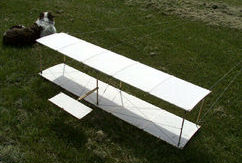
1. To prepare the kite for launch, simply rest it on
the ground. Attach the control strings to the ends of the two
control sticks and the ends of the two outboard struts, as Wilbur
shows in his diagram. Check that all four strings are the same
length
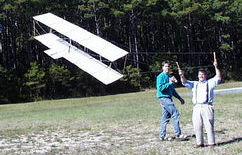
3. If the wind is steady, the kite will begin to fly.
Resist the temptation to run with the kite to get it into the air -- it doesn't work.
You must be turned toward the kite and facing it at all times. I have
launched the kite by walking backward briskly, but this has it's own
dangers.
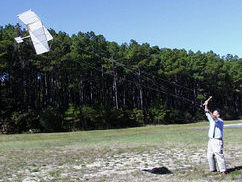
5. Here's how to roll the kite -- angle the control
sticks in opposite directions. Normally, you shouldn't have to angle them
this far. Wilbur's diagram shows the control lines crossed -- apparently
he turned the sticks end for end from the way I hold them. Maybe this made
flying easier for him, but it didn't for me. Each to his own.
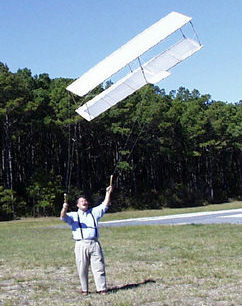
7. Once you get a good, steady wind, practice rolling
the kite back and forth until you can keep it aloft for long periods of
time. (For me, that's about five minutes.) Loosen the fore-to-aft bracing strings so there's just a little play in them and you
can rock the wings back and forth and inch or two without twisting them.
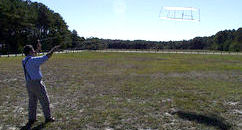
9. This will probably be the most difficult part of
your pilot training -- learning to control the pitch and the roll
together. When you get the hang of doing both at the same time , you can fly the kite
low to the ground...
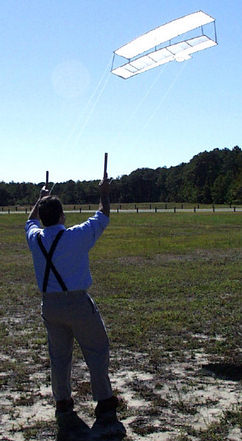
11. Or anywhere in between. |
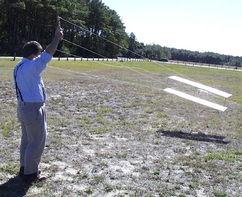
2. If the wind is strong
enough, you can launch the kite like an airplane. With it resting on the ground,
tug on the two bottom strings and the kite will begin to rise. In lighter winds, have someone hold it up
as high as possible and tug on the bottom strings.
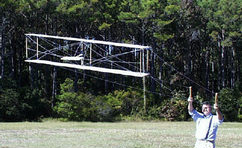
4.
You must begin to control the kite the moment it leaves the ground. If you have trouble launching and getting control of
the kite, try shortening the control lines. Remember, the longer the strings, the longer
the delay between your control movements and the time the kite actually
responds.
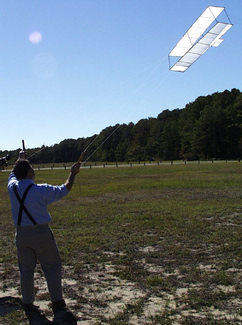
6. Once you've gotten a little practice, you should be
able to make slower, gentler rolls without warping the wings overmuch. If
the kite continues to act squirrelly, check the wind. Is it gusty? That'll
do it. Also check your surroundings. Are you flying near trees or
buildings? These can interfere with the wind, causing "waves.".
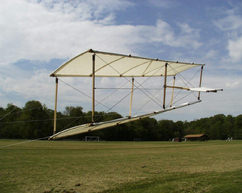
8. Launch the kite, get it flying steadily, and try to
make it dive or climb by putting in a little pitch control. Do this by angling the control sticks in the same
direction. As the wings rock, the tail will go up or down. This, in turn,
will cause the kite to nose down or nose up. If the kite dives or climbs
to fast, you may have loosened the bracing strings too much.
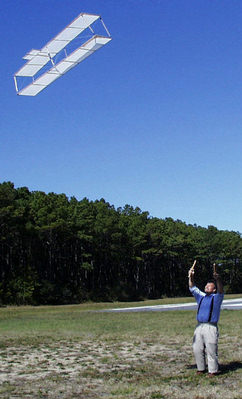
10. High in the air...
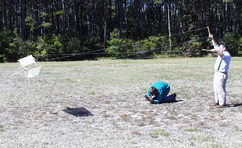
12. And once in a while, if you're extremely good (or
extremely lucky), you can even bring it in for a landing. |